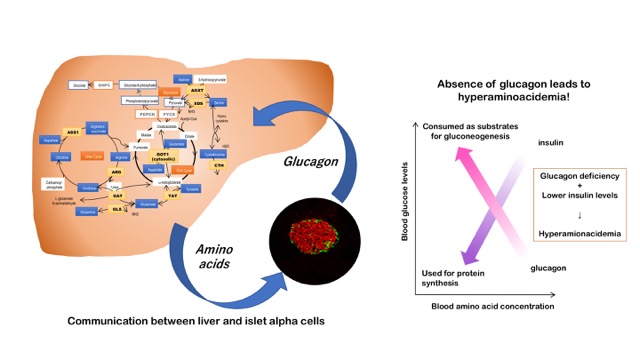Endocrinology

Staff



Research Projects
Department of Endocrinology aims to find new strategies to prevent or control endocrinological/metabolic disorders including diabetes mellitus. To achieve this purpose, our major approach is development and analysis of gene-modified animal models that is useful to understand pathophysiology of such disorders. Glucagon is mostly described as a hormone that increases blood glucose levels and aggravates diabetes mellitus. However, our research using a mouse model lacking glucagon gene clarified that glucagon is essential for homeostasis of amino acid metabolism.
As we have also found that glucagon plays pivotal roles in regulation of nicotinamide metabolism, we are currently analyzing a novel animal model deficient in enzyme that metabolize nicotinamide.
Researches on cardiac arrhythmia and electrophysiological disorders, using optical action potential mapping technique and human Hoter ECG data analysis, are also going on (driven by Honjo and Ueda).

Selected Publications
- Takeda K, Nemoto KI, Hayashi Y, Yamamoto M, Sakuta R, Kimura T, Noto H Two mutations in thyroid hormone receptor beta gene (P453A and C36Y) in a family with resistance to thyroid hormone with comorbid myotonic dystrophy. Thyroid 2019 (in press)
- Maekawa R, Seino Y, Ogata T, Murase M, Iida A, Hosokawa K, Joo E, Harada N, Tsunekawa S, Hamada Y, Oiso Y, Inagaki N, Hayashi Y, Arima H. Chronic high-sucrose diet increases fibroblast growth factor 21 production and energy expenditure in mice. The Journal of Nutritional Biochemistry 49: 71-79, 2017.
- Iida A, Seino Y, Fukami A, Maekawa R, Yabe D, Shimizu S, Kinoshita K, Takagi Y, Izumoto T, Ogata H, Ishikawa K, Ozaki N, Tsunekawa S, Hamada Y, Oiso Y, Arima H, Hayashi Y. Endogenous GIP ameliorates impairment of insulin secretion in proglucagon-deficient mice under moderate beta cell damage induced by streptozotocin. Diabetologia 59: 1533-1541, 2016.
- Takano Y, Kasai K, Takagishi Y, Kikumori T, Imai T, Murata Y, Hayashi Y Pancreatic neuroendocrine tumors in mice deficient in proglucagon-derived peptides. PLoS One 10: e0133812, 2015.
- Kinoshita K, Ozaki N, Takagi Y, Murata Y, Oshida Y, Hayashi Y Glucagon is essential for adaptive thermogenesis in brown adipose tissue. Endocrinology 155: 3484-3492, 2014
- Fukami A, Seino Y, Ozaki N, Yamamoto M, Sugiyama C, Sakamoto-Miura E, Himeno T, Takagishi Y, Tsunekawa S, Ali S, Drucker DJ, Murata Y, Seino Y, Oiso Y, Hayashi Y. Ectopic expression of GIP in pancreatic ß-cells maintains enhanced insulin secretion in mice with complete absence of proglucagon-derived peptides.Diabetes 62: 510-518, 2013.
- Watanabe C, Seino Y, Miyahira H, Yamamoto M, Fukami A, Ozaki N, Takagishi Y, Sato J, Fukuwatari T, Shibata K, Oiso Y, Murata Y, Hayashi Y. Remodeling of hepatic metabolism and hyperaminoacidemia in mice deficient in proglucagon-derived peptides. Diabetes 61: 74-84, 2012
- Hayashi Y, Yamamoto M, Mizoguchi H, Watanabe C, Ito R, Yamamoto S, Sun XY, Murata Y. Mice deficient for glucagon gene-derived peptides display normoglycemia and hyperplasia of islet alpha-cells but not of intestinal L-cells. Molecular Endocrinology 23: 1990-1999, 2009
- Ogawa T, Honjo H, Yamazaki M, Kushiyama Y, Sakuma I, Kodama I, Kamiya K. Ranolazine facilitates termination of ventricular tachyarrhythmia associated with acute myocardial ischemia through suppression of late INa-mediated focal activity. Circulation Journal 81: 1411-1418, 2017
- Kushiyama Y, Honjo H, Niwa R, Takanari H, Yamazaki M, Takemoto Y, Sakuma I, Kodama I, Kamiya K. Partial IK1 blockade destabilizes spiral wave rotation center without inducing wave breakup and facilitates termination of reentrant arrhythmias in ventricles. American Journal of Physiology Heart and Circulatory Physiology 311: H750-H758, 2016
- Ueda N, Yamamoto M, Honjo H, Kodama I, Kamiya K. The role of gap junctions in stretch-induced atrial fibrillation. Cardiovascular Research 104: 364-370, 2014
(Apr 5, 2019)
